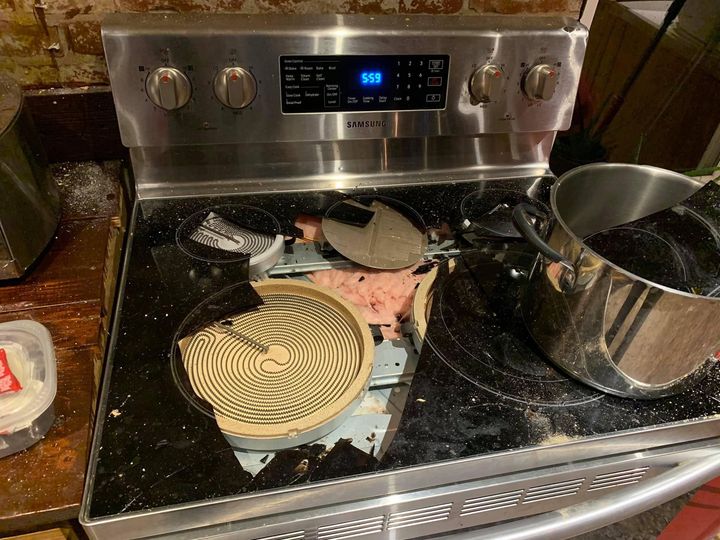Glass top stoves bring a sleek, modern look to any kitchen, adding a polished, minimalist touch that appeals to many homeowners. Their flat, smooth surfaces are easy to clean and provide a streamlined aesthetic, perfect for contemporary kitchen designs. However, despite their stylish appearance and practical benefits, glass top stoves come with unique risks that homeowners might not always be aware of. A simple mistake, such as placing a hot lid in the wrong spot, could result in a shattered cooktop, transforming your kitchen’s centerpiece into a costly and potentially hazardous mess.
The Appeal and Risks of Glass Top Stoves
In recent years, glass top stoves have surged in popularity due to their elegant design and the ease of maintenance they offer. Unlike traditional coil stoves, which can trap crumbs, spills, and grime, glass tops are smooth and lack any crevices, making cleanup straightforward and quick. Additionally, their sleek surface complements various kitchen styles, fitting well in both minimalist and modern aesthetics. However, while tempered glass is durable and built to withstand heat, it is not entirely immune to damage. Under certain conditions, a glass top stove can become vulnerable, presenting hidden dangers that many people might not anticipate.

Why Placing Hot Lids on the Glass Top Can Cause Shattering
One of the most common yet dangerous mistakes people make is placing a hot lid directly facedown on the glass cooktop. At first glance, it seems harmless—after all, it’s just a lid, right? However, this simple action can actually create a vacuum seal between the hot lid and the glass surface, which can lead to catastrophic results.
- Vacuum Seal Formation: When you place a hot lid on a glass cooktop, the heat trapped between the lid and the surface can create a vacuum seal. This seal causes the lid to adhere tightly to the glass, creating a dangerous situation.
- Pressure Buildup and Cracking: As the cooktop cools down, the trapped heat between the lid and the glass surface can create a pressure difference. This pressure can eventually cause the glass to crack, often resulting in a spiderweb pattern of fractures across the surface. Such cracks compromise not only the aesthetic of your stove but also its structural integrity.
The Dangers of a Cracked Glass Top Stove
A cracked glass top stove is more than just a cosmetic issue; it’s a serious safety concern. Cooking on a cracked stove can put you and your household at risk for injuries or accidents. Here’s why it’s best to avoid using a damaged glass cooktop:
- Safety Risks: A cracked glass surface is significantly more likely to shatter under high temperatures or the weight of cookware. If it breaks, it can send glass shards flying, which poses a risk of burns, cuts, or other serious injuries.
- Heating Problems: Cracks can also interfere with the stove’s heating elements, leading to uneven heating. This not only affects the quality of your cooking but could also cause electrical short-circuits, which might spark fires or lead to further damage.
Tips for Protecting Your Glass Top Stove
Taking proactive steps to prevent damage can save you from costly repairs and the hassle of dealing with a cracked stove. Here are some practical measures to keep your glass top stove in top condition:
- Avoid the Hot Lid Trap: Instead of placing a hot lid directly on the cooktop, use a heat-resistant trivet or place the lid on a cool, flat surface. This small change can make a big difference, helping you avoid the risks associated with a vacuum seal.
- Use Compatible Cookware: Selecting the right cookware is essential for maintaining a glass cooktop. Opt for pots and pans with flat, smooth bottoms to reduce the likelihood of scratching the glass. Additionally, when using heavy cookware, such as cast iron, handle it carefully to prevent accidental drops that could shatter the glass.
- Regular Cleaning: Keeping your stove clean is one of the easiest ways to preserve its surface. Wipe down the glass after each use to remove any food particles, which, if trapped under cookware, can cause scratches over time. Even small scratches weaken the glass and increase its susceptibility to cracking under pressure.
What to Do If You Notice a Crack on Your Glass Top Stove
If you spot a crack on your glass top stove, it’s crucial to stop using it immediately. Cooking on a cracked surface heightens the risk of the glass shattering completely, which could be extremely dangerous. Here’s what to do if you notice damage:
- Assess the Damage: Determine the severity of the crack. Smaller cracks may be reparable, while larger ones often necessitate a complete glass top replacement. If you’re unsure, contact a professional to assess the damage.
- Repair or Replace: For minor cracks, repairs may be possible, but deep or extensive cracks usually indicate it’s time to replace the cooktop. A professional technician can provide guidance on the best course of action, ensuring the stove’s safety and functionality are restored.
Final Thoughts: Keep Your Glass Top Stove Safe
Glass top stoves are a beautiful and functional addition to any kitchen, bringing both style and ease of maintenance. Yet, they do require a bit of extra care to prevent damage and avoid costly repairs. By understanding the potential risks of placing a hot lid on the cooktop and following simple preventive steps, you can extend the life of your glass top stove and keep your kitchen safe.
So, the next time you’re preparing a meal, remember these tips to protect your glass top stove. Avoid placing hot lids directly on the surface, choose compatible cookware, and keep the cooktop clean. With a little extra attention, you’ll not only maintain the stove’s pristine appearance but also enjoy its sleek, efficient performance for years to come. Taking these precautions will allow you to make the most of your glass top stove, combining safety with style to create a kitchen you can truly enjoy.



